The Apple iPad 2 Review
by Brian Klug, Anand Lal Shimpi & Vivek Gowri on March 19, 2011 8:01 PM ESTThe iPad 2
We've already gone over the iPad 2's design in our preview so I won't spend a ton of time here. The first iPad was a pain to hold in your hand, the iPad 2 largely addresses that problem. The device is similarly sized to its predecessor but Apple removed significant volume by tapering the edges of the iPad 2. The tablet is thus more comfortable to hold, lighter and is significantly thinner than its predecessor. Apple likes to point out that the iPad 2 is now thinner than even the iPhone 4.
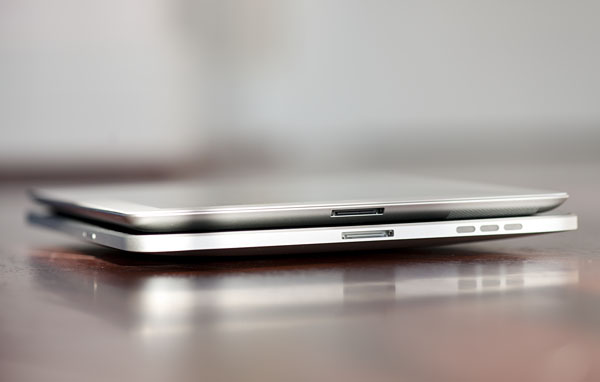
Apple iPad 2 (top), Apple iPad (bottom)
The Xoom to me was more pleasant to hold that the original iPad, however the iPad 2 takes the crown back from Motorola. I believe we'll see second generation Android tablets that rival the iPad 2's thickness but for now you have to keep in mind that we're comparing a second generation iOS tablet to first generation Android tablets. With smartphone internals and virtually nonexistent cooling requirements, building a thin tablet isn't an impossible task.
The front of the iPad 2 is pretty much unchanged from the original, with the exception of the new VGA front facing camera (720p rear camera). As we'll get to shortly, beneath the front of the iPad 2 are a number of magnets for use with Apple's new smart covers. The front bezel of the iPad 2 is available in both white and black. Surprisingly all of the AnandTech editors who contributed to this review opted for the white and all of us seemed to actually be pretty happy with the choice.
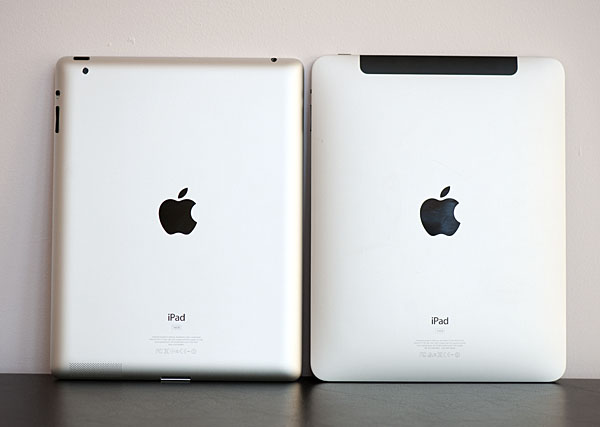
Apple iPad 2 (left), Apple iPad (right)
Flip the iPad 2 around and the back is a very familiar aluminum. Unfortunately with no protection back here you'll often find yourself laying the iPad 2 face down on a smart cover when it's not in use. Even on a clean desk I could hear tons of little particles grinding up against the aluminum. So far the iPad 2 has been pretty resilient, implying that it's made of a harder aluminum than what Apple uses in the MacBook Pro line. That being said, I still worry about scratching the back of the device. Apple makes beautiful products but their beauty isn't always durable.
The button setup hasn't changed since the original iPad. There's the familiar home button on the front (which feels a little softer than the original, but in a good way) and power/lock button up top.
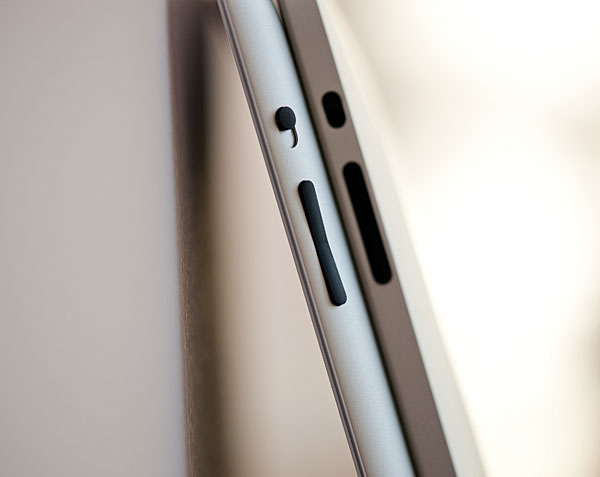
Apple iPad 2 (left), Apple iPad (right)
Along the right side are the mute/rotation switch and the volume rocker. The ends of the volume rocker protrude out further in the iPad 2 than they did with the original - yet another welcome change.
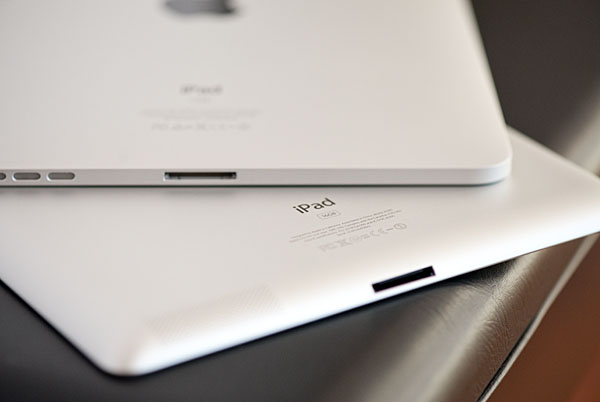
Apple iPad 2 (bottom), Apple iPad (top)
The dock connector is arguably the biggest flaw in the design. Because of the angled edges of the new iPad, the dock connector actually finds itself located in the middle of a slope. As a result inserting a standard dock cable is a bit awkward. On the original iPad you could just line up the cable with the middle of the bottom edge and sneak it in, on the iPad 2 there's more of a guessing game - usually involving me scraping the cable side dock connector against the aluminum back looking for the mate.
Just like last time the iPad 2 is available in both WiFi and 3G versions. The 3G versions add A-GPS support will the WiFi version can only pinpoint your location using WiFi trilateration. Apple offers separate AT&T and Verizon editions of the iPad 2, both of which have the same black antenna bar along the top of the back face of the tablet.
| Apple iPad 2 Pricing Comparison | |||||
| 16GB | 32GB | 64GB | |||
| WiFi | $499 | $599 | $699 | ||
| AT&T 3G | $629 | $729 | $829 | ||
| Verizon 3G | $629 | $729 | $829 | ||
NAND capacities haven't increased, nor have prices. We likely won't see an increase in storage capacity until 25nm NAND ships in greater volume. The iPad 3 will probably start at 32GB and go all the way up to 128GB as a result.
Regardless of carrier, the 3G models require a $130 premium over the WiFi only models. Personally I'd say that some sort of cellular data connectivity is really necessary to make the iPad 2 as useful as possible. Whether that comes from a 3G model or through a MiFi/smartphone hotspot doesn't really matter.
The pricing as a whole is still absurd. Even if you opt for the $499 WiFi version you'll be out another $39 for a case, plus another $39 if you want the HDMI adapter and then there are all of the apps you will likely start buying. This is an expensive platform to buy into and rest assured that there will be an even faster version out next year. Apple hasn't had much pricing pressure from the competition, however as we mentioned in our CES 2011 coverage - ASUS will be shipping a $399 Honeycomb tablet this year that should start to change that.


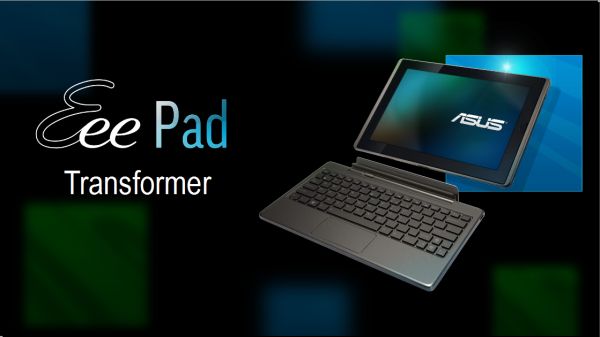








189 Comments
View All Comments
PeteH - Saturday, March 19, 2011 - link
In the Garage Band section:"There are three Smart Instruments - Piano, Bass, Guitar, and Drums."
I'm pretty sure that "three" should be a "four."
VivekGowri - Sunday, March 20, 2011 - link
Ahaha, I'm an idiot - thanks for catching that, it'll be fixed.PeteH - Sunday, March 20, 2011 - link
As far as typos go that one isn't remotely bad. I once published a spec (internally) that had a section detailing how asynchronous boundaries were handled in my section of a chip. Unfortunately I had titled that section "Cock Domain Crossings."Anand Lal Shimpi - Sunday, March 20, 2011 - link
A few years ago I used the word overcocking instead of overclocking in an article.UNLK A6 - Saturday, March 19, 2011 - link
I'd like some clarification about LINPACK and Geekbench. Are these benchmarks created by compiling some portable code for each platform as a measure of floating point performance? Or, is this supposed to be some measure of how fast one can do linear algebra or DSP on the platform? On Mac OS and iOS, one wouldn't compile say LINPACK for this but use the hand-tuned LAPACK/BLAS and DSP routines built into Apple's Accelerate Framework. The difference between the two can be huge. Which do these benchmarks purport to supply--generic floating point performance or available linear algebra and DSP performance on the platform?metafor - Sunday, March 20, 2011 - link
I believe Linpack on both iOS and Android are plainly compiled (by the JIT in the case of Android) to run on the platform. They don't make any calls against the onboard DSP's nor do they use NEON beyond what the compiler is able to auto-vectorize.name99 - Sunday, March 20, 2011 - link
Apple supplies all the Linpack routines in optimized NEON code as part of the OS (in the Accelerate framework). Intelligent apps that need them use those routines.Android, as far as I know, does not provide an equivalent.
You can use apps that deliberately bypass these iOS routines if you wish to get a handle on the raw FP performance of the hardware, but
(a) it doesn't give actual linear algebra performance, if that is something your app or algorithm really cares about AND
(b) it's kinda dumb because if you care about fp performance in any way, you'll be using NEON, so what's the value in a benchmark that doesn't exercise NEON?
nimus - Sunday, March 20, 2011 - link
I hope AnandTech can do a comprehensive comparison of the usability/feature strengths between the Android, Apple iOS, BlackBerry Tablet OS (QNX), HP webOS, and any others tablet OSes.It will be interesting to see how the Windows Tablet OS will be able to compete when it finally is released for ARM processors.
KidneyBean - Sunday, March 20, 2011 - link
I'm using a tablet, so I can't see the mouse-over pics :-(tcool93 - Sunday, March 20, 2011 - link
I don't know where the reviewer gets the idea Netbooks are much faster. That is nonsense. Here is a video showing an ARM 9 processor being just as fast, yet the ARM 9 processor is running 1/3 the speed of the Netbook Atom. (500mhz vs. 1600mhz for the Netbook).http://www.youtube.com/watch?v=W4W6lVQl3QA&fea...
The Netbook also has a graphics accelerator in it, and the ARM shown in this video doesn't.